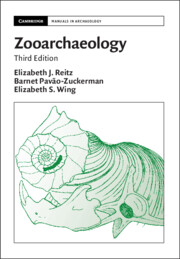Refine search
Actions for selected content:
281 results
6 - The Right to Mental Health
- from Part II - The Positive Dimension
-
- Book:
- Minds, Freedoms and Rights
- Published online:
- 21 December 2025
- Print publication:
- 22 January 2026, pp 134-156
-
- Chapter
-
- You have access
- Open access
- HTML
- Export citation

Zooarchaeology
- Coming soon
-
- Expected online publication date:
- January 2026
- Print publication:
- 18 December 2025
-
- Textbook
- Export citation
Chapter 5 - Galen’s delirium: hot and dry dusKrasia of the hêgemonikon
- from Part I - Delirium
-
- Book:
- Impaired Consciousness in Ancient Medical Texts
- Published online:
- 04 December 2025
- Print publication:
- 04 December 2025, pp 57-75
-
- Chapter
-
- You have access
- Open access
- HTML
- Export citation
Chapter 9 - Sleep in post-Hellenistic sources
- from Part II - Sleep
-
- Book:
- Impaired Consciousness in Ancient Medical Texts
- Published online:
- 04 December 2025
- Print publication:
- 04 December 2025, pp 110-132
-
- Chapter
-
- You have access
- Open access
- HTML
- Export citation
Chapter 4 - Delirium, madness and disease among post-Hellenistic authors
- from Part I - Delirium
-
- Book:
- Impaired Consciousness in Ancient Medical Texts
- Published online:
- 04 December 2025
- Print publication:
- 04 December 2025, pp 36-56
-
- Chapter
-
- You have access
- Open access
- HTML
- Export citation
Chapter 8 - Sleep in the Hippocratic corpus
- from Part II - Sleep
-
- Book:
- Impaired Consciousness in Ancient Medical Texts
- Published online:
- 04 December 2025
- Print publication:
- 04 December 2025, pp 88-109
-
- Chapter
-
- You have access
- Open access
- HTML
- Export citation
Chapter 6 - Final remarks about delirium and the notion of disease: a diachronic look
- from Part I - Delirium
-
- Book:
- Impaired Consciousness in Ancient Medical Texts
- Published online:
- 04 December 2025
- Print publication:
- 04 December 2025, pp 76-82
-
- Chapter
-
- You have access
- Open access
- HTML
- Export citation
Chapter 3 - Delirium versus madness and the notion of disease in the Hippocratic corpus
- from Part I - Delirium
-
- Book:
- Impaired Consciousness in Ancient Medical Texts
- Published online:
- 04 December 2025
- Print publication:
- 04 December 2025, pp 23-35
-
- Chapter
-
- You have access
- Open access
- HTML
- Export citation
Chapter 11 - Sleep and the mind: an overview of ideas that did not change
- from Part II - Sleep
-
- Book:
- Impaired Consciousness in Ancient Medical Texts
- Published online:
- 04 December 2025
- Print publication:
- 04 December 2025, pp 146-148
-
- Chapter
-
- You have access
- Open access
- HTML
- Export citation
Chapter 2 - Definitions of delirium/wakeful impaired consciousness versus madness, and the concept of ‘disease’
- from Part I - Delirium
-
- Book:
- Impaired Consciousness in Ancient Medical Texts
- Published online:
- 04 December 2025
- Print publication:
- 04 December 2025, pp 19-22
-
- Chapter
-
- You have access
- Open access
- HTML
- Export citation
Chapter 10 - Sleep in Galen
- from Part II - Sleep
-
- Book:
- Impaired Consciousness in Ancient Medical Texts
- Published online:
- 04 December 2025
- Print publication:
- 04 December 2025, pp 133-145
-
- Chapter
-
- You have access
- Open access
- HTML
- Export citation

Irish Romanticism
- A Literary History
-
- Published online:
- 27 November 2025
- Print publication:
- 11 December 2025
7 - Medicine, Science, and the Environment
-
-
- Book:
- Explaining the History of American Foreign Relations
- Published online:
- 24 October 2025
- Print publication:
- 13 November 2025, pp 139-160
-
- Chapter
- Export citation

Biology and Medical Theory
-
- Published online:
- 31 October 2025
- Print publication:
- 04 December 2025
-
- Element
- Export citation
Constructing Health Regions in Late Colonial French Africa
-
- Journal:
- Itinerario , First View
- Published online by Cambridge University Press:
- 07 October 2025, pp. 1-14
-
- Article
-
- You have access
- Open access
- HTML
- Export citation
5 - Irritation
- from Part III - Unsettling Environments: Threat, Loss, and Precarity in Russia’s Peatlands
-
- Book:
- Burning Swamps
- Published online:
- 06 September 2025
- Print publication:
- 25 September 2025, pp 171-197
-
- Chapter
- Export citation
Effects of climate and within-tree competition on cocoa pod production in Ghana
-
- Journal:
- Experimental Agriculture / Volume 61 / 2025
- Published online by Cambridge University Press:
- 29 August 2025, e25
-
- Article
-
- You have access
- Open access
- HTML
- Export citation
7 - Public Health
- from Part II - Application Case Chapters
-
- Book:
- Cities and Environmental Change
- Published online:
- 15 August 2025
- Print publication:
- 28 August 2025, pp 134-158
-
- Chapter
- Export citation
21 - The maintenance of Hispanic dominance in Latin America
-
-
- Book:
- The Cambridge History of War
- Published online:
- 18 July 2025
- Print publication:
- 14 August 2025, pp 513-529
-
- Chapter
- Export citation
Chapter 11 - Disability
- from Part II - Social Contexts
-
-
- Book:
- Sean O'Casey in Context
- Published online:
- 23 June 2025
- Print publication:
- 10 July 2025, pp 120-129
-
- Chapter
- Export citation
